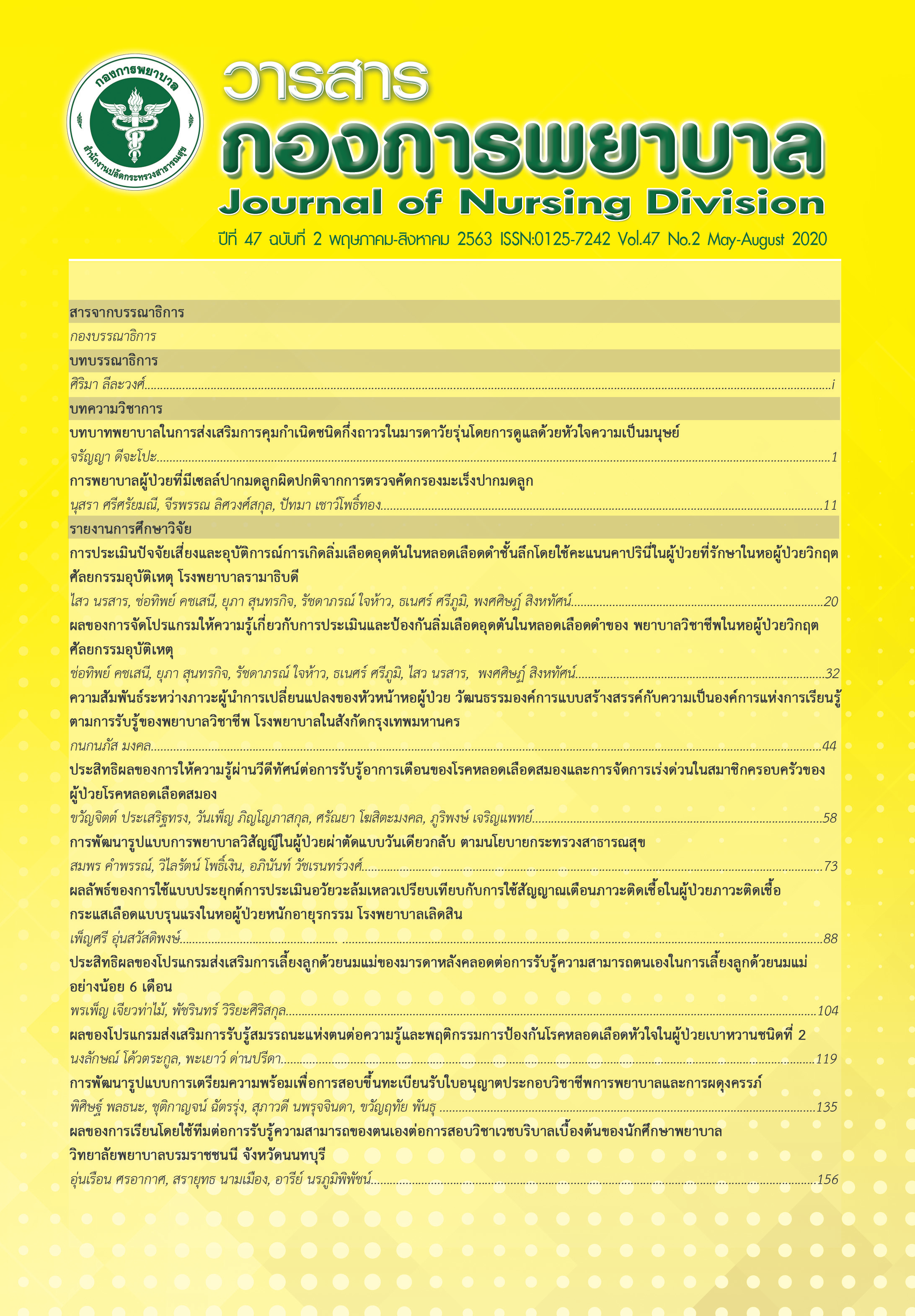ผลของการจัดโปรแกรมให้ความรู้เกี่ยวกับการประเมินและป้องกันลิ่มเลือดอุดตันในหลอดเลือดดำของพยาบาลวิชาชีพในหอผู้ป่วยวิกฤตศัลยกรรมอุบัติเหตุ
Main Article Content
บทคัดย่อ
การวิจัยนี้เป็นการวิจัยกึ่งทดลอง เพื่อศึกษาผลของการจัดโปรแกรมให้ความรู้เกี่ยวกับการประเมินและป้องกันลิ่มเลือดอุดตันในหลอดเลือดดำของพยาบาลวิชาชีพจำนวน 11 คน ที่ปฏิบัติงานในหอผู้ป่วยวิกฤตศัลยกรรมอุบัติเหตุ พยาบาลผู้เข้าร่วมโครงการได้รับโปรแกรมความรู้ ดังนี้ 1) คู่มือการพยาบาลเพื่อป้องกันลิ่มเลือดอุดตันในหลอดเลือดดำ 2) วิดิทัศน์ความรู้เรื่องการประเมินอาการของลิ่มเลือดอุดตันในหลอดเลือดดำชั้นลึก 3) แบบประเมินและคัดกรองความเสี่ยงต่อการเกิดลิ่มเลือดอุดตันในหลอดเลือดดำชั้นลึกของคาปรินี่ที่แปลโดยผู้วิจัย และ 4) แนวทางการพยาบาลเพื่อป้องกันลิ่มเลือดอุดตันในหลอดเลือดดำ เครื่องมือที่ใช้ในการเก็บรวบรวมข้อมูล เป็นแบบทดสอบความรู้ก่อนและหลังได้รับโปรแกรมให้ความรู้ ประกอบด้วยข้อคำถาม 3 ด้าน จำนวน 60 ข้อ วิเคราะห์ข้อมูลโดยใช้สถิติ ค่าเฉลี่ย ส่วนเบี่ยงเบนมาตรฐาน และ Wilcoxon signed rank test
ผลการศึกษา พบว่า ค่าเฉลี่ยคะแนนความรู้ก่อนและหลังได้รับโปรแกรมการให้ความรู้ของพยาบาลผู้เข้าร่วมโครงการวิจัย จำนวน 11 คน มีความแตกต่างกันอย่างมีนัยสำคัญทางสถิติ (p = .003) โดยหลังจากได้รับโปรแกรมการให้ความรู้ พยาบาลผู้เข้าร่วมโครงการทำข้อสอบได้คะแนนอยู่ในระดับดีมาก (ตอบถูกร้อยละ 89.9) การศึกษาครั้งนี้มีข้อเสนอแนะว่าควรมีการปรับปรุงและพัฒนาสื่อการสอน เน้นการให้ความรู้เพิ่มเติมในหัวข้อที่ผู้เข้าร่วมโครงการวิจัยตอบถูกน้อย การจัดโปรแกรมให้ความรู้อย่างต่อเนื่อง และจำเป็นต้องมีการศึกษาวิจัยเพิ่มเติมต่อไป
Article Details
เอกสารอ้างอิง
2. Champon W, Kidakorn K, Suthas H, et al. Deep venous thrombosis in surgical intensive care unit: prevalence and risk factors. Asian J Surg. 2009;32(2):85–8.
3. Supparerk P, Monravee T, Suvit S, et al. Incidence and associated factors of deep vein thrombosis in Thai surgical ICU patients without chemoprophylaxis: One Year Study. J Med
Assoc Thai. 2015;98(5):472-8.
4. Tang X, Sun B, Yang Y, Tong Z. A Survey of the Knowledge of Venous Thromboembolism Prophylaxis among the Medical Staff of Intensive Care Units in North China. PLoS One.
2015;10(9): e0139162.
5. O'Brien A, Redley B, Wood B, Botti M, Hutchinson AF. STOPDVTs: Development and testing of a clinical assessment tool to guide nursing assessment of postoperative patients for
Deep Vein Thrombosis. J Clin Nurs.2018;27(9-10):1803-11.
6. Streiff MB, Lau BD, Hobson DB, et al. The Johns Hopkins Venous Thromboembolism Collaborative: Multidisciplinary team approach to achieve perfect prophylaxis. J Hosp Med.
2016;11 Suppl 2:S8-14.
7. Porntip S, Ketsarin U. Application of Evidence-based Practice for Deep Vein Thrombosis Prevention in Medical-Surgical Patients. J Nurs Sci. 2011;29(2):27-36. Thai.
8. Imberti D, Becattini C, Bernardi E, et al. Mulitdisciplinary approach to the management of patients with pulmonary embolism and deep vein thrombosis: a consensus on diagnosis,
traditional therapy and therapy with Rivaroxaban. Intern emerg Med. 2018;13(7):1037-49.
9. Ma YF, Xu Y, Chen YP, et al. Nurses’ objective knowledge regarding venous thromboembolism prophylaxis: A national survey study. Medicine (Baltimore). 2018;97(14): e0338.
10. Oh H, Boo S, Lee JA. Clinical nurses’ knowledge and practice of venous thromboembolism risk assessment and prevention in South Korea: a cross-sectional survey. J Clin
Nurs.2017;26(3-4): 427-35.
11. Marauyad Y, Pranee S. Sampling for research [Internet]. 2018 [cited 2019 Aug 20]. Available from: http://www.fsh.mi.th/km/wp-content/uploads/2014/04/resch.pdf. Thai.
12. Caprini JA. Thrombosis Risk Assessment as a Guide to Quality Patient Care. Dis Mon. 2005;51(2-3):70-8
13. Pasunun P. Evaluation of inter-rater reliability using Kappa statistics. J Faculty Applied Art. 2015; 8(1):2-20. Thai.
14. Das S, Sahoo A, Swain R. Effectiveness of the Planned Teaching Program on Deep Vein Thrombosis among the Staff Nurses of selected hospital. JNHS. 2014;3(1):48-51.
15. Al-Dorzi HM, Cherfan A, Al-Harbi S, et al. Knowledge of Thromboprophylaxis guidelines pre- and post-didactic lectures during a venous Thromboembolism awareness day at a
tertiary-care hospital. Ann Thorac Med. 2013;8(3):165-9.
16. Lau BD, Shaffer DL, Hobson DB, et al. Effectiveness of two distinct web- based education tools for bedside nurses on medication administration practice for venous
thromboembolism prevention: A randomized clinical trial. PLoS ONE. 2017;12(8):e0181664.


